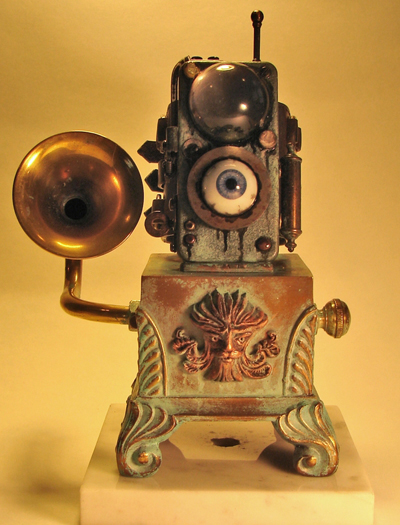
It began with a simple internet search for new lighting design ideas. In the end, Arthur Donovan of Southampton uncovered a new art and design movement, and the discovery landed him in England as the curator of an exhibition at the Oxford Museum of the History of Science and perhaps the world’s foremost interpreter of the Steampunk aesthetic.
For the uninitiated, Steampunk takes elements of modern technology and antiquated mechanical parts and reimagines them to yield devices and contraptions that look for all the world like they were created by Jules Verne or some half-mad scientist of the Victorian era. Components such as cogs, wheels, springs, gas lights, gauges, and gas masks put together with antiqued brass, bronze and copper are typical of Steampunk. Science fiction also plays a prominent role in the Steampunk aesthetic.
Steampunk sensibility can be found in “20,000 Leagues Under the Sea,” “The League of Extraordinary Gentlemen,” “The Golden Compass” and director Guy Ritchie’s “Sherlock Holmes.” In all of these, elements of art and design are woven into functional inventions that would be considered futuristic for the time period or fantasy world in which the stories are set.
Exposed mechanical workings are a prominent part of the design. One of Steampunk’s hallmarks is the ability to see how things “work.” Its roots can be found in the technological advances of the Victorian era, when steam power was seen as a global game-changer for the human race. Steampunk combines technology of the past with an imagined future to create the fantastical.
“The style just hit me right between the eyes,” said Mr. Donovan, who had been working for years in lighting design. “It immediately worked in style for me as an illumination specialist. I just ran with it.”
Mr. Donovan’s foray into Steampunk took his own lighting designs in a new direction. His table lamps, lanterns and illumination creations took a sharp turn into the sculptural and began including complex elements.
Soon, Mr. Donovan’s website searching revealed an underground arts/design movement that was just beginning to percolate. His interest quickly turned into passion as computer clicks allowed him to “find” creative types working in Steampunk style.
He began compiling a list of his favorite Steampunk artists, sculptors, designers and filmmakers and discovered that there were pockets of Steampunk practitioners around the world—many of whom might not even identify their style as Steampunk.
In August 2008, Mr. Donovan curated “The World’s First Exhibition of Steampunk Art + Design” at Hamptons Antique Galleries in Bridgehampton. The show unveiled Mr. Donovan’s new Steampunk line along with works by 11 other artists and designers. Contributors hailed from France, the Netherlands and the United States.
Based on the strength of that show, Mr. Donovan suggested a Steampunk exhibition at the Museum of the History of Science in Oxford. To pique visitors’ interest, Mr. Donovan paired samples of recent Steampunk works with historic scientific inventions held in the museum’s collection. The idea was embraced by museum director Dr. Jim Bennett.
On October 13, 2009, Mr. Donovan became the curator of the “world’s first museum show of Steampunk.” Since the show opened, he has been featured on television shows, in magazine and newspaper features and in podcasts explaining the Steampunk movement and how the exhibition came about.
The exhibition features an international lineup of designers and artists. Mr. Donovan has several pieces in the show including sculptural lighting pieces and a clock fashioned from brass, glass, gears and other eclectic materials.
Steampunk designers and artists include Amanda Scrivener, Tom Banwell, “Dr. Grymm” (aka Joey Marsocci), Haruo Suekichi, “Herr Doktor,” Jos De Vink, Thomas D. Willeford, Vianney Halter and others. Portions of the exhibition can be viewed at www.mhs.ox.ac.uk/steampunk.
Additional programming by the museum includes screening cult favorites and new films that incorporate a Steampunk aesthetic.
Steampunk fashion presentations, workshops on how to make mechanical devices with gears (like clocks and movie cameras), and student competitions for coming up with practical Steampunk inventions are all part of the show. The exhibition remains on view through February 21, 2010.
For Mr. Donovan, the experience of curating the Steampunk exhibition for the Oxford museum has been exciting. Many of the designers and artists attended the opening, giving Mr. Donovan the chance to meet Steampunk enthusiasts he admires. And incorporating Steampunk into his commercial lighting has brought a playfulness into his design process.
“I’ve never had so much fun in my life, as an artist,” he said, “and that’s the truth.”
Information on the Steampunk exhibition at the Museum of the History of Science at the University of Oxford can be found at www.steampunkmuseumexhibition.blogspot.com. Mr. Donovan’s designs can also be viewed at www.donovandesign.com.